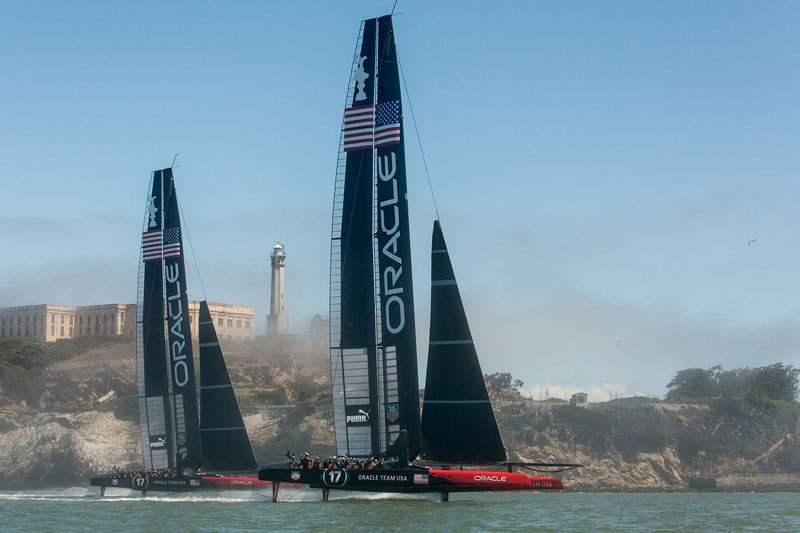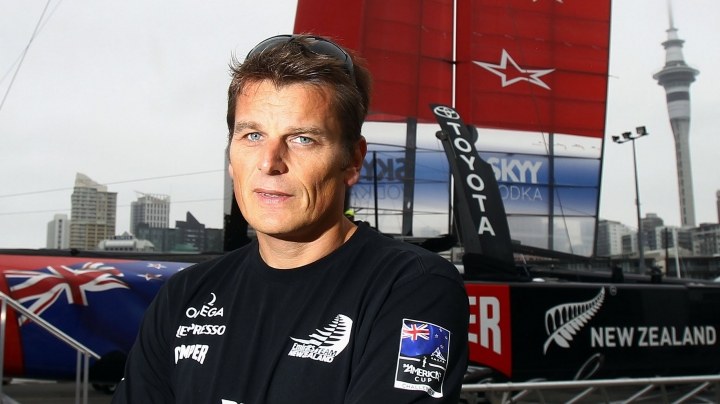
AC Cups Permits, Rudders & Elevators

The U.S. Coast Guard has given the America’s Cup folks the Marine Event Permit required to conduct the America’s Cup on the Bay this summer. It was just in the nick of time, as the fleet parade and time trials will be held on July 5, and the first race of the Louis Vuitton (Challenger) Cup is slated for July 7. (Find the full schedule for Opening Weekend HERE.)
We’re assuming that the Louis Vuitton will go off on the 7th, but given the litigious nature of the America’s Cup, we’ll believe it when we see it. Indeed, the Emirates New Zealand team has already filed a protest with the International Jury, one that will be heard on July 8.
The Marine Event Permit was predicated on the implementation of the 37-point Safety Plan created after the death of Artemis’ Andrew Simpson. Most of the syndicates don’t have a problem with most of the new requirements — except the Kiwis and others when it comes to the three points of the Safety Plan that deal with rudders and elevators.
When the AC72 class was created, it was based on the assumption that the cats wouldn’t plane. But the Kiwis spent thousands of hours figuring out a way around it. Once they got foiling, everybody had to catch up. Some (Oracle) did it more quickly than others (Artemis).
The deal with foiling is that the more you can control the pitch, the less likely your chances of pitchpoling at 40 knots. The Kiwis say they have managed to figure out a way to do it within the parameters of the original AC72 design that has been proven safe in more than 60 days of sailing. But that it required them to make some compromises to the structure and such that weren’t in the best interests of performance.
That said, most people agree that they AC72s could be safer if the rudders were allowed to be deeper and the elevators larger than was permitted in the original design parameters. Oracle has apparently been working on the assumption that deeper rudders and bigger elevators will be allowed, which may have allowed them to have leapfrogged the understandably angry Kiwis in this critical design area.
It’s easy to side with the Kiwis, who argue that it’s unfair to change the design rules so late in the game. But with one America’s Cup death already, and everyone acknowledging that the AC72s are way overpowered and dangerous on the Bay, it’s hard to argue against anything that promotes safety.
Aussie Iain Murray, the Independent Director for the America’s Cup, explained why he included the controversial three points when applying for the Marine Event Permit:
“I have exercised my professional judgment to the best of my ability, and have weighed carefully the unfortunate circumstances thrust upon us including (as a paramount consideration) the need to increase the safety of our crews, the officials and other Bay users, as well as the investment made by Competitors and all other stakeholders in this event. Safety is not a multiple-choice selection from which Competitors pick and choose. I have issued this Regatta Notice as being in the best collective interests of the America’s Cup as a long-standing institution in and at the pinnacle of our sport.”
For those interested in the minutia of all this, Emirates Team New Zealand skipper Dean Barker took a crack at it in his June 30 blog:
"There has been a lot of discussion in the media centred mainly around the issue of the rudder and rudder elevators. In the AC72 Class Rule you are allowed to build rudder elevators which are not allowed to exceed the maximum beam of the yacht, nor extend aft of one metre forward of the stern plane of the yacht. The AC72 class was never envisioned to fully foil, however through 1000s of hours of design and testing we made a decision that our first AC72 would be a fully foiling yacht.

"To do this we needed to increase the engineering of a number of components of the boat to accept the extra loading as a boat comes clear of the water. We also took design compromises to allow us to build a boat which would foil in a stable and reliable fashion. The compromise was often straight line speed, but a compromise we felt necessary for safety and the ability to push the boat hard.
"The Safety Recommendations included a number of points regarding the rudders and rudder elevators. The main ones were imposing a minimum rudder length of 2.1m, introducing a minimum elevator area of 0.32m2, removing the maximum beam rule which effectively allows the elevators to extend outside the beam of the boat, and insisting the elevators must be symmetrical in plan view.
"We agree with imposing a minimum length of rudder even though this made one of our set of rudders illegal. We also thought it was sensible to impose a minimum elevator area. However, we are completely opposed to allowing elevators to extend outside of maximum beam and having to be symmetric.
"Allowing the rudder elevators to extend outside of max beam is incredibly dangerous and introduces serious risk for the crew. If a crew member was to fall overboard from either hull while the boat is foiling, there is a much greater chance they would be struck by the longer elevator and this would lead to a serious injury. As the rule is currently written, with the elevators limited to maximum beam, the chance of injury is greatly reduced.
"The second point we are completely opposed to is having to make the elevators symmetric in plan view. We took a clear compromise when designing our boat to position our rudder bearings to allow us to build an elevator to the size we felt necessary. With the existing class rule it is possible to build an elevator well in excess of the imposed minimum area. From day one of sailing our AC72 yachts, we have sailed with asymmetric elevators.
"We have now done well over 60 days with these elevators and have never had a structural issue with either rudders or elevators. It is completely unnecessary to impose the requirement for the elevators to be symmetric in plan form. There is no logical argument to say that asymmetric elevators are not safe."
